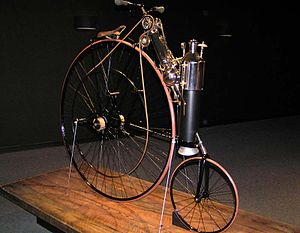 A Copeland replica at the Art of the Motorcycle (Memphis) exhibition | |
| Manufacturer | Lucius Copeland |
|---|---|
| Production | 1884 |
| Engine | Single steam cylinder |
| Top speed | c. 15 mph (24 km/h) |
| Power | 4 hp (3.0 kW) @ 2,600 RPM |
| Transmission | Single speed, belt drive |
| Frame type | American Star Bicycle steel frame |
The Copeland steam bicycle was a steam powered, two-wheeled motor vehicle made by Lucius Copeland in 1881 and is sometimes classed as an early motorcycle.
In 1881 Copeland designed an efficient small steam boiler which could drive the large rear wheel of a Columbia penny-farthing to a speed of 12 miles per hour (19 km/h). Unlike typical penny-farthing bicycles, the Copeland had a small wheel at the front, which was turned by the handlebar for steering, and large wheel at the back.[1][2]
In 1884 Copeland used an American Star bicycle, smaller steering wheel in front, to construct a new demonstration vehicle for the Maricopa County Fair that year.[2] The "Star" was able to cover a mile in four minutes and to carry enough water to operate for an hour. Copeland set up the Northrop Manufacturing Co. in 1887 in Camden, New Jersey, to produce a three-wheeled version, the "Phaeton Moto-Cycle", which he demonstrated at the Smithsonian Institution in Washington D.C in 1888.[1]
The steam-powered engine produced 4 horsepower[3] at 2600 rpm with a 100-pound (45 kg) boiler around the steering column with the water heated by kerosene. A simple leather belt drove the large rear wheel, yielding a top speed of around 15 miles per hour (24 km/h).[4]

- ^ a b Cite error: The named reference
Burgesswas invoked but never defined (see the help page). - ^ a b Cite error: The named reference
automobile1915was invoked but never defined (see the help page). - ^ "Antique Motorcycles: Early Steam-Cycle History". KHI Inc. 2009. Archived from the original on 10 August 2010. Retrieved 23 September 2010.
- ^ "Copeland Steam Motorcycle". patentpendingblogs. 11 March 2007. Retrieved 23 September 2010.